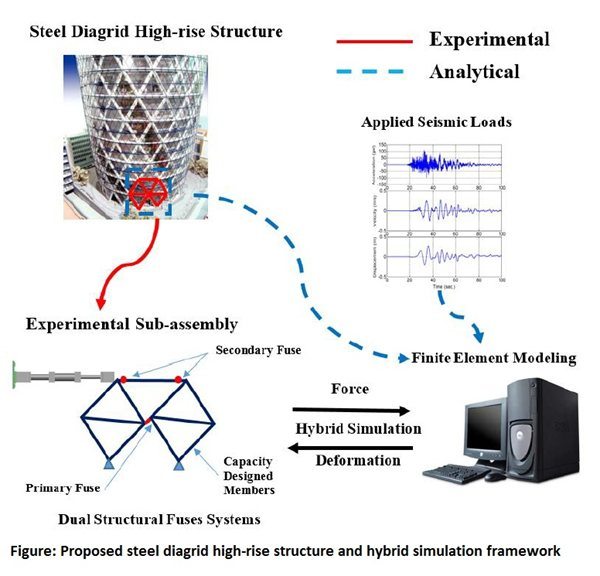2016
Dr. Tony Yang
Department of Civil Engineering, University of British Columbia
Development of Innovative Steel Diagrid High-Rise Structures for Seismic Applications
This research aims to create an innovative steel diagrid structure for high-rise building applications in areas of high seismicity. This system utilizes the high stiffness and strength of steel to create a diagonally integrated mega steel grid structure that can transfer lateral loads to the foundation efficiently and effectively. The combination of the mega steel grid system with the gravity system allows the designers to create new architectural flexibility, achieving new buildings heights and shapes that cannot be achieved using conventional structural systems. Thus far, the use of diagrid structure has not been implemented in areas of high seismic zones because the dynamic behaviour of diagrid structures under seismic loads are not fully understood.
The proposed steel diagrid structure will utilize the efficiency and energy dissipation capacity of steel, so it can be built in areas of high seismicity. In this research, detailed nonlinear finite element models will be developed. They will be used to study the dynamic behaviour of steel diagrid structures under different earthquake shaking intensities. The model responses will be used to develop efficient seismic energy dissipation devices. To improve construction and cost efficiency, steel modular construction methods (See grant years 2014 and 2015) will be utilized. The seismic performance of the proposed steel diagrid structure will be validated using the advanced experimental testing technique, hybrid simulation, at the state-of-the-art Structural Laboratory at the University of British Columbia. Once the performance of the steel diagrid structure has been systematically validated, detailed seismic design procedures will be developed to allow structural engineers to efficiently and effectively design steel diagrid structures for high-rise constructions worldwide. Upon successful completion of the research, new and advanced steel high-rise structures will be developed.
BIOGRAPHY
Dr. Tony Yang received his B.Sc. (2001) and M.Sc. (2002) from the University at Buffalo, New York, and his Ph.D. from the University of California, Berkeley in 2006. His research focus on improving the structural performance through advanced analytical simulation and experimental testing. He has developed the next-generation performance-based design guidelines (adopted by the Applied Technology Council, the ATC-58 research team) in the United States; developed advanced experimental testing technologies, such as hybrid simulation and nonlinear control of shake table, to evaluate structural response under extreme loading conditions; developed risk-based simulation models for countries in the North and South America and the Global Earthquake Model (GEM) for the counties in the South East Asia. Dr. Yang has been actively involved in using novel technologies, such as base isolation systems and dampers, to improve structural performance. He has working with leading structural engineering firms to peer-reviewed landmark buildings, including the tallest steel plate shear wall structure in the world. Dr. Yang is an active member of the Tall Buildings Initiative Project, funded by the Pacific Earthquake Engineering Research Center, to develop seismic design guidelines for tall buildings. Dr. Yang co-developed ‘OpenSees Navigator’, a software program widely used by design engineers and researchers to design and analyze complex structural systems. He has also developed ‘PBEE’, a software program to quantify facility loss under extreme events.


